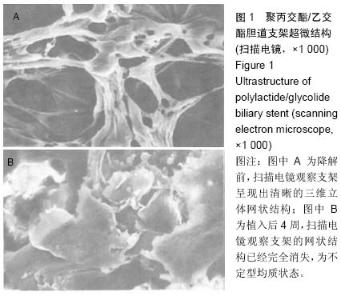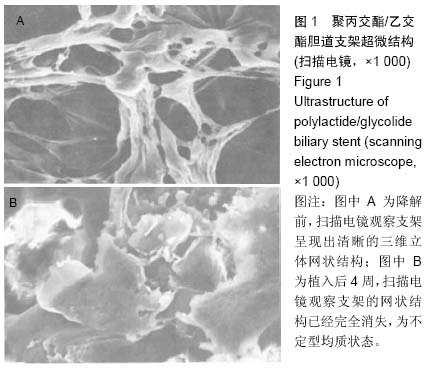| [1] 瞿旭东,颜志平,王建华,等.经皮穿肝胆道引流术(PTCD)辅助支架置放治疗胆管和十二指肠恶性梗阻[J].复旦学报(医学版), 2012, 39(3):289-292.
[2] 潘涛,马羽佳,刘兆玉,等.经皮胆道射频消融术治疗恶性胆道梗阻支架再狭窄1例[J].中国临床医学影像杂志,2014,25(8): 605-607.
[3] 梁勇.内镜下逆行胰胆管造影置放胆道支架治疗胆道恶性梗阻46例疗效观察[J].重庆医学,2011,40(25):2549-2551.
[4] 肖亿,潘光栋.无痛内镜下胆道金属支架联合胰管支架治疗壶腹周围癌[J].肝胆胰外科杂志,2013,25(4):287-289.
[5] 姜中华,杨红梅,王正江,等.胆道、十二指肠支架置入治疗胆道合并十二指肠恶性梗阻[J].中国微创外科杂志,2014,14(12):1112-1115.
[6] 韩冰,于良,苗山,等.聚丙交酯/乙交酯胆道支架的体外降解规律及力学特性[J].中国组织工程研究与临床康复,2008,12(45): 8939- 8942.
[7] 于良,韩冰,苗山,等.聚丙交酯/乙交酯胆道支架的体外降解规律及力学特性[J].第四军医大学学报,2007,28(23): 2138- 2140.
[8] 王菲,周洪,郭昱成,等.纳米羟基磷灰石/壳聚糖/聚丙交酯支架的体外生物相容性和成骨活性[J].中国组织工程研究,2014,18(8): 1198-1204.
[9] 侯宇川,王春喜,郑佐柱,等.生物降解输尿管支架材料丙交酯/乙交酯共聚物的生物相容性及体内外降解特性[J].吉林大学学报(医学版),2005,31(4):526-529.
[10] 章培标,武汉,王新,等.可降解高分子丙交酯-乙交酯共聚物(PLGA)三维支架的细胞相容性和鼻软骨组织工程[J].组织工程与重建外科杂志,2006,2(2):88-91.
[11] 玉银华.输尿管支架生物降解材料丙交酯-乙交酯共聚物在体外的降解及临床应用[J].中国组织工程研究与临床康复,2011, 15(21):3949-3952.
[12] 冀明,王拥军,李鹏,等.全覆膜与非覆膜金属支架治疗胆道恶性梗阻随机对照研究[J].中华消化内镜杂志,2012,29(12): 673-675.
[13] 谭志刚,郭奕彤.胆管支架置入联合锁骨下动脉药盒贯序化疗治疗肝门部胆管癌:不同种类支架选择对治疗效果有影响吗?[J]中国组织工程研究与临床康复,2009,13(52): 10377-10381.
[14] Yu XJ, Wang L, Huang MT, et al. A shape memory stent of poly(ε-caprolactone-co-DL-lactide) copolymer for potential treatment of esophageal stenosis. J Mater Sci. 2012;23(2): 581-589.
[15] Sternberg K, Kramer S, Nischan C, et al. In vitro study of drug-eluting stent coatings based on poly(L-lactide) incorporating cyclosporine A-drug release, polymer degradation and mechanical integrity. J Mater Sci. 2007;18(7): 1423-1432.
[16] Grabow N, Bunger CM, Schultze C, et al. A biodegradable slotted tube stent based on poly(L-lactide) and poly(4-hydroxybutyrate) for rapid balloon-expansion. Ann Biomed Eng. 2007;35(12):2031-2038.
[17] 赵冬梅,蒋丹娜,刘侠,等.塑料与金属胆管支架的材料特征及其生物相容性[J].中国组织工程研究与临床康复,2011,15(8): 1463-1466.
[18] 何国林,徐小平,周陈杰,等.一种恶性梗阻性黄疸介入治疗的新方法-经皮肝穿刺胆道内射频消融内支架置入术[J].南方医科大学学报,2011,31(4):721-723.
[19] Han Y, Fan ZY, Lu ZQ, et al. In vitro Degradation of Poly [(L-lactide)-co-(trimethylene carbonate)] Copolymers and a Composite with Poly[(L-lactide)-co-glycolide] Fibers as Cardiovascular Stent Material. Macromol Mater Eng. 2012; 297(2):128-135.
[20] 陈欣然,陆仁达,周鸣清,等.胆道塑料支架治疗高龄高危胆总管结石患者[J].肝胆胰外科杂志,2011,23(5):413-415.
[21] 高荣,刘迎龙,于存涛,等.聚乙交酯-聚丙交酯降解支架复合胎儿脐动脉细胞构建组织工程血管的动物实验研究[J].内蒙古医学院学报,2009,31(6):605-609.
[22] 程友,黄金中,全大萍,等.构建聚丙交酯-乙交酯共聚物包埋甲壳胺无纺布的新型高聚物材料支架[J].中国临床康复,2005,9(18): 60-61.
[23] 潘海涛,郑启新,郭晓东,等.骨髓基质干细胞与聚丙交酯/乙交酯/天冬氨酸/聚乙二醇体外复合培养的实验研究[J].中国修复重建外科杂志,2007,21(1):65-69.
[24] 刘文革,林海淋.绿荧光蛋白基因修饰的大鼠骨髓间充质干细胞复合聚丙交酯-乙交酯膜的形态学观察[J].中国综合临床,2010, 26(6):620-623.
[25] 王身国,崔文瑾,贝建中,等.聚内酯类生物降解性高分子微球可注射细胞支架[J].组织工程与重建外科杂志,2005,1(1):12-17.
[26] 王金瑞,于良,师建华,等.新型可降解镁合金胆道支架的体外降解规律及力学性能[J].中国组织工程研究,2014,18(25): 3980-3986.
[27] 王敬,孟波,周宁新,等.可降解聚乳酸支架在胆管损伤治疗中作用的实验研究[J].中华肝胆外科杂志,2004,10(12):841-843.
[28] Han YR, Jin XY, Yang J, et al. Totally Bioresorbable Composites Prepared From Poly(L-Lactide)-co-(Trimethylene Carbonate) Copolymers and Poly(L-Lactide)-co-(Glycolide) Fibers as Cardiovascular Stent Material. Polymer Eng Sci. 2012;52(4):741-750.
[29] 王菲.纳米羟基磷灰石/壳聚糖/聚丙交酯复合支架体外细胞相容性的实验研究[C].全球华人口腔医学大会暨2010中国国际口腔医学大会论文集,2010,425-425.
[30] Schliecker G, Schmidt C, Fuchs S, et al. Effect of copolymer ratio on hydrolytic degradation of poly(lactide-co-glycolide) films: effect of oligomers on degradation rate and crystallinity. Int J Pharm. 2003;266(1-2):39-49.
[31] 张萌,齐民,刘洪泽,等.聚丙交酯-乙交酯聚合物(PLGA)涂层体外降解行为研究[J].功能材料,2006,37(2):277-280.
[32] 张凯.胆道内可降解支架的体内及体外的实验性研究[D].长春:吉林大学,2004.
[33] 徐克,夏永辉,冯博,等.雷帕霉素-多聚丙交酯乙交酯药膜洗脱支架结构设计和体外药代动力学研究[J].中国介入影像与治疗学,2007,4(6):473-477.
[34] 周益峰,刘岩,李兆申,等.胆胰管可降解支架的实验研究进展[J].中华胰腺病杂志,2013,13(6):422-424.
[35] 刘韶晖.胆总管探查后内置可降解的支架并Ⅰ期缝合胆总管的实验性研究[D].长春:吉林大学,2003.
[36] Zhu Y, Hu C, Li B et al. A highly flexible paclitaxel-loaded poly(ε-caprolactone) electrospun fibrous-membrane-covered stent for benign cardia stricture. Acta Biomater. 2013;9(9): 8328-8336.
[37] 黄浩哲,李文涛.生物可降解胆道内支架的研究进展[J].中华肝胆外科杂志,2013,19(5):390-393.
[38] 高杰,赵文华,崔凯,等.胆道支架的临床应用现状[J].国际外科学杂志,2011,38(5):325-328.
[39] 张凯,刘铜军,梁显军,等.聚乳酸/羟基乙酸胆总管支架体外胆汁中的降解实验[C].普外进展论坛孟宪民基金会首届学术讨论会暨第十二届全国普外基础与临床进展学术大会论文汇编,2005: 388-390.
[40] 朱艳萍,蒋丹娜,赵芮,等.胆管支架的临床应用及其生物相容性[J].中国组织工程研究与临床康复,2009,13(43):8556-8559.
[41] Catto V, Farè S, Cattaneo I, et al. Small diameter electrospun silk fibroin vascular grafts: Mechanical properties, in vitro biodegradability, and in vivo biocompatibility. Mater Sci Eng C Mater Biol Appl. 2015;54:101-111.
[42] Pita PC, Pinto FC, Lira MM, et al. Biocompatibility of the bacterial cellulose hydrogel in subcutaneous tissue of rabbits. Acta Cir Bras. 2015;30(4):296-300.
[43] Pu J, Yuan F, Li S, Komvopoulos K. Electrospun bilayer fibrous scaffolds for enhanced cell infiltration and vascularization in vivo. Acta Biomater. 2015;13:131-141.
[44] Cui H, Cui L, Zhang P, et al. In situ electroactive and antioxidant supramolecular hydrogel based on cyclodextrin/ copolymer inclusion for tissue engineering repair. Macromol Biosci. 2014;14(3):440-450.
[45] Cui H, Liu Y, Cheng Y, et al. In vitro study of electroactive tetraaniline-containing thermosensitive hydrogels for cardiac tissue engineering. Biomacromolecules. 2014;15(4):1115- 1123.
[46] Valence Sd, Tille JC, Chaabane C, et al. Plasma treatment for improving cell biocompatibility of a biodegradable polymer scaffold for vascular graft applications. Eur J Pharm Biopharm. 2013;85(1):78-86.
[47] Sabri F, Sebelik ME, Meacham R, et al. In vivo ultrasonic detection of polyurea crosslinked silica aerogel implants. PLoS One. 2013;8(6):e66348.
[48] P?troi D, Gociu M, Prejmerean C, et al. Assessing the biocompatibility of a dental composite product. Rom J Morphol Embryol. 2013;54(2):321-326.
[49] Willbold E, Kalla K, Bartsch I, et al. Biocompatibility of rapidly solidified magnesium alloy RS66 as a temporary biodegradable metal. Acta Biomater. 2013;9(10):8509-8517.
[50] Sabri F, Boughter JD Jr, Gerth D, et al. Histological evaluation of the biocompatibility of polyurea crosslinked silica aerogel implants in a rat model: a pilot study. PLoS One. 2012;7(12): e50686. |

